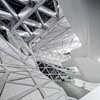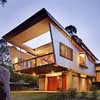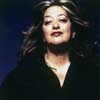Contemporary Architecture, New Building Designs, Architects, Style, Links
Contemporary Architecture
Information on Current Buildings across the Globe
There are four ways of searching for contemporary buildings on the site:
World Architecture – by country
City Buildings – by city
World Buildings – by type
Architects – by architect
Contemporary Architecture Design
This site focuses on contemporary buildings. However, a basic understanding of what contemporary often denotes is useful.
Certainly within the field of architecture the phrase denotes not just new or modern by age (ie by default) but something deliberately of our time. The phrase ‘zeitgeist’ is often used to describe something which – as the German translation suggests – is truly ‘of our time’, that is in the spirit of the time.
To take an example, Le Corbusier would consider his main body of buildings (middle period anyway, around the thirties) to reflect the times in the same way the planes and cars did, but other architects’ contemporaneous buildings – in say the Classical style – to not be contemporary. Thus contemporary buildings should exude the nature of the time in which they are built and not use past styles or typographies.
Swiss Re Building, City of London design by the Foster + Partners architets office:

picture © Adrian Welch
Contemporary Buildings suggests forms and spaces that are anti-vernacular, comfortable with new technology and non-local materials & forms, using architectural language that is not generally steeped in past typographies or traditions.
Over recent decades there have been periods in certain parts of the world of intense polarisation between the contemporary approach and what has been termed ‘traditional’, an age-old debate between old and new. Often the debate has dealt with what is deemed appropriate, and with context and quality, though style frequently is referenced.
Guangzhou Opera House, China design by Zaha Hadid Architects:

photo : Virgile Simon Bertrand
The contemporary building phrase carries a certain amount of baggage, more so than ‘new’ or ‘current’ as a description when applied to the built environment, but less than ‘Modern’. Modern with a capital m is of course a style fixed in history and ironically no longer modern!
Currently contemporary architecture seems focused on icon-making, each famous architect trying to outdo the next to design more and more outlandish structures. Globalisation, branding and an increase in ‘speed’ throughout our culture can result in skin-deep architecture that grabs the attention but does not provide deeper, rooted meaning.
Various countries have their own individual debates and agendas. In the UK a polarity grew in the eighties (largely thanks to Prince Charles) between traditional and contemporary. The latter camp is dominant and more numerous but the establishment is quetioned, in fact more questioning would be healthy.
Depot Beach House design by Peter Stutchbury in Australia:

photo © Michael Nicholson
In Australia Lindsay Johnson has described two camps of architecture approaches – “the “Touch this Earth Lightly” (Glenn learned of this now famous Aboriginal saying from his friend Brian Klopper) camp from the east coast, who draw their inspirations from the ground through the soles of their feet, led by Glenn Murcutt and, then, what I called the “Radical Avant-garde”, mostly centred on Melbourne in Victoria, who draw their inspirations through the crowns of their skulls out of the ethersphere, more concerned with international trends, styles and theoretical positions”.
In most European countries contemporary architecture is completely in the driving seat whereas in the US there is definitely more traditionalism with many designs combining classical elements with modern technology and materials.
Comments re the Contemporary Architecture page welcome
Contemporary Architects – Definition Summary

image from STV
Contemporary Building Architects
Zaha Hadid Architects
SANAA Architects
Contemporary Architecture – City Guides
e-architect categorise architecture geographically, historically and typologically. We focus on new architecture but fo feature the full historical range of buildings.
Contemporary Architect Photos

photograph : Steve Double
Comments / photos for the Contemporary Buildings + New Architecture page welcome.
